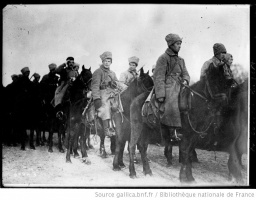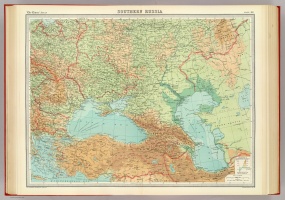Initial Hostilities in 1919↑
The first clash of arms between the Poles and Bolsheviks took place in Vilnius in January 1919, shortly after the Germans had abandoned the city. The Poles had just established their own self-defence troops. Poland had no eastern border and the Bolsheviks wanted to expand their revolution to Western Europe, making war between them inevitable. A short time later the Red Army captured the city.
Poland’s head of state, Józef Piłsudski (1867-1935), decided to launch an offensive in order to recapture the city. This operation proved to be a success, because the Bolsheviks were also heavily engaged in fighting against the counterrevolutionary White Russian troops. Polish troops advanced as far as the Beresina River, while their forces to the left remained at the Dvina River. A White victory in the Russian Civil War would have been counterproductive for Poland, since its territory could then have been limited to the Bug River in favour of White Russia. For that reason, the Poles refrained from any further offensive action, allowing the Bolsheviks to overcome the counterrevolutionary threat of the White Russian troops.
Campaign of 1920↑
Polish-Ukrainian Offensive on Kiev↑
In 1919, hostilities were quite limited since the Bolsheviks were heavily engaged in the civil war in Russia. As stated before, the Poles were not interested in a White victory. Furthermore, they made the most of the low activity on the front, using the time to organize their forces. It was obvious that a strong campaign a year later would be decisive for the entire war. Both sides – the Bolsheviks and the Poles – thus prepared for a powerful offensive.
Pilsudski succeeded in forming an alliance with Symyon Petliura (1879-1926), president of the Ukrainian People’s Republic. Petliura wanted to preserve an independent Ukrainian state, albeit at the cost of Eastern Galicia, which he agreed to cede to Poland. The allies started the campaign by attacking Kiev, which was finally freed from Bolshevik control in early May 1920. However, they were unable to install an effective Ukrainian administration in the captured territories before a massive counteroffensive began.
Soviet Summer Counteroffensives and March to the Vistula↑
At the end of May 1920, the Soviet 1st Horse Army emerged on the Ukrainian front, forcing the Polish troops to retreat. Shortly afterwards, Mikhail Tukhachevskii (1893-1937), commander of the northern front, launched his own offensive in the direction of Vilnius, Minsk and Warsaw. Both forces were approximately equal – the Poles and the Ukrainians had about 110,000 to 120,000 soldiers while Bolsheviks possessed 120,000 to 140,000.
On 5 July 1920, the Polish front in the north collapsed. The Poles who sought British mediation were obliged to accept harsh conditions: namely to agree to the River Bug as their Eastern border and to grant Vilnius to Lithuania. However, the Bolsheviks were so convinced of their ultimate victory that they rejected the settlement and continued hostilities. At the beginning of August 1920, they had moved the front to the Bug and captured the fortress of Brest Litovsk.
Battle of the Vistula↑
The Polish situation was critical given the intensified enemy pressure at the Bug River. Thus, it was necessary to retreat to the last possible line of defence – the Vistula River. The Polish high command decided to regroup and form an assault group on the Wieprz River, on the left flank of the Soviet advance. The Poles were determined to defend the right bank of the Vistula in the vicinity of Warsaw, which resulted in heavy fighting. Apart from concentrating their forces in that area, the Soviets also advanced in the northern direction in order to cross the Vistula north of the Polish capital and capture it from the western side, as happened in 1831.
During those dramatic days in mid-August 1920, the Poles succeeded not only in stopping the advance towards Warsaw, but also in regrouping their forces in preparation for a massive counteroffensive. On 15 August 1920, the day of the Assumption of the Blessed Virgin Mary, the Poles attacked on the left flank; a day later they began an attack on the right wing from the Wieprz line. The enemy was completely surprised and failed to put up any significant resistance.
The "Manoeuvre from Wieprz" was an operational masterpiece. It is difficult to determine its authorship, but most probably it was either the Polish chief of the general staff, General Tadeusz Rozwadowski (1866-1928), or the head of state and supreme commander, Josef Pilsudski. The contribution of French General Maxime Weygand (1867-1965), who is sometimes credited with the initiative, is somewhat unlikely, since French doctrine favoured static warfare. In the course of the Vistula battle, the Soviets' northern front was crushed. The remnants withdrew to the east or crossed the German border in East Prussia and applied for internment. However, the Germans sent them back to Russia.
Battle of the Neman↑
The last main battle of the war took place at the Neman River between 20 and 26 September 1920. This time the Poles attacked from the outset. Despite some Soviet counterattacks, the Polish troops crushed the enemy's resistance. Tukhachevskii had to retreat and his front found it impossible to restrain the Polish forces in pursuit. However, the Poles were also exhausted, so both sides decided to sign a truce in October 1920.
Peace Treaty in Riga↑
The peace negotiations were conducted in the Latvian capital of Riga. Since the Poles had been victorious, they would have been entitled to demand a border well to the east of the River Bug. The members of the Polish delegation, however, were unwilling to incorporate too much territory where Poles would be a minority. Therefore, Minsk was left to the Bolsheviks and the new border was drawn well to the west of the ceasefire line. The new frontier closely resembled the old one of the years 1793-1795, of course with some corrections in favour of Poland.
Jarosław Centek, Nicolaus Copernicus University, Poland
Section Editor: Piotr Szlanta










